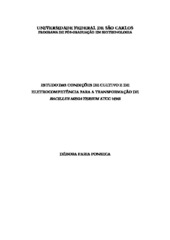Estudo das condições de cultivo e de eletrocompetência para a transformação de Bacillus megaterium ATCC 14945
Abstract
The Gram-positive genus Bacillus is of great biotechnological importance. Their
ability to secrete enzymes efficiently during fermentation is exploited for the production
of extracellular enzymes such as penicillin G acylase (PGA). Bacillus megaterium has
proven to be an excellent alternative host to Escherichia coli for heterologous gene
expression. Unlike other bacilli strains, proteolytic degradation by alkaline proteases is
avoided. In addition, there are no endotoxins found in the cell wall. As a result, protein
yields are exceptionally high even if inexpensive substrates are used.
In this work, the growth conditions of B. megaterium ATCC 14945 and its
preparation for transformation by electroporation with plasmid DNA had been studied.
Vegetative cells and protoplasts of B. megaterium had been used. Plasmid DNAs (pET-
32, pETduet-1, pBR322 and pHis 1522) were prepared from E. coli strains DH5α and
BL21. Bacteria cultures were growth in Luria-Bertani (LB) broth, Nutrient or LBS (LB
containing 0,5 M sorbitol) medium.
It had been used the following Electroporation Media: 25% PEG 6000/0.1 M
Sorbitol (Moro et al., 1995), 0.625 M Sacarose/1.0 mM MgCl2, pH 5.5 (Dunny et al.,
1991), HEPES 10 mM, pH 7.0 (Belliveau & Trevors, 1989) and SMG (0.5 M sorbitol,
0.5 M manitol and 10% glicerol) (Xue et al., 1999). As Recovery Media after electric
pulses, LB and LBSM (LB containing 0,5 M sorbitol and 0.38 M manitol) had been
used.
Extractions of genomic DNA of B. megaterium and plasmid DNA of E. coli had
been carried through. The Colonies Forming Units method (CFU) was applied in order
to analyze the B. megaterium viability before and after treatment with Electroporation
Media. The biomass produced (Cx) was analyzed spectrophotometrically and by the
Dry Mass method. The morphology and pureness of B. megaterium cultures had been
studied by optic microscopy preparations and B. megaterium growth in liquid selective
media. The best electric conditions for electroporation had been established by
preliminary tests. B. megaterium transformations was performed according to protocols
described by Moro et al. (1995), Dunny et al. (1991), Belliveau & Trevors (1989), Xue
et al. (1999) and Romero et al. (2006).
The B. megaterium growth curves in LB, Nutrient and LBS had allowed the
identification of growth phases of cultures and the respective electric conditions
adjustment for electroporation protocols.
The cellular concentration (dry mass) found for 16 hours of culture in Nutrient,
LB and LBS medium had been 1.900 g/L, 2.649 g/L and 2.320 g/L, respectively.
The viable cells concentration analyses (UFC) had allowed the adjustment of
plasmid DNA concentrations employed and transformation efficiencies calculation.
It had been found the following cellular densities of B. megaterium grown in
Nutrient, LB and LBS medium respectively after PEG/Sorbitol Electroporation Medium
treatment: 8.8 x 108; 9,2 x 108 and 2.3 x 109 UFC/mL. For Sacarose/MgCl2, it had been
found 2,8 x 107; 4.6 x 108 and 3.7 x 108 UFC/mL and for HEPES 5.6 x 108; 2.93 x 109
and 1.86 x 108. For SMG, it had been found 1,7 x 109; 9.4 x 109 and 1.1 x 1010 UFC/mL
for Nutrient, LB and LBS medium, respectively.
